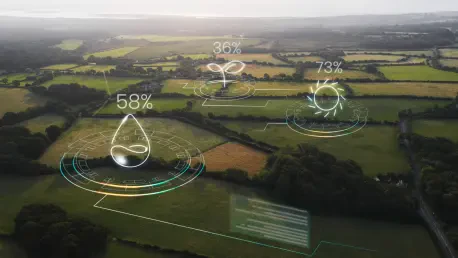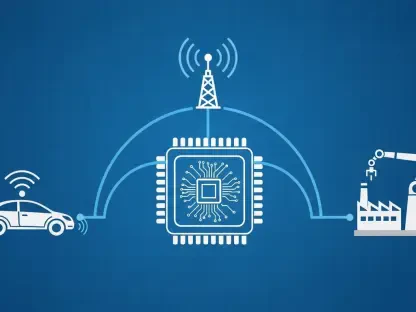In the fast-paced world of industrial digitalization, private 5G networks and edge computing are proving to be revolutionary forces for the manufacturing sector, offering far more than just enhanced connectivity or speed. These technologies are fundamentally transforming how industries operate by boosting operational efficiency, cutting costs, and placing a strong emphasis on environmental sustainability. As global pressures mount to achieve carbon neutrality and adhere to stringent ESG (Environmental, Social, and Governance) standards, adopting such innovations has become a critical strategy for companies striving to maintain a competitive edge in the Industry 4.0 landscape. The promise of a factory where downtime is virtually eliminated, energy waste is drastically reduced, and processes are optimized in real-time is no longer a distant dream but a tangible reality shaped by these advancements. This sets the stage for a deeper exploration into how such tools are paving the way for a more efficient and responsible industrial future.
The Backbone of Industrial Transformation
Revolutionizing Connectivity and Efficiency
Private 5G networks and edge computing are at the forefront of redefining industrial operations by tackling persistent challenges in connectivity and data handling. With ultra-low-latency communication, private 5G enables seamless integration of AI-driven systems and IoT devices, ensuring that real-time applications like autonomous robots operate without a hitch. Meanwhile, edge computing processes data at the source, eliminating delays associated with distant cloud servers and enhancing decision-making speed. This combination is crucial for tasks such as predictive maintenance, where identifying equipment issues before they escalate can save significant time and resources. The result is a dramatic reduction in unplanned downtime, with early industrial pilots demonstrating throughput increases of up to 15%, fundamentally altering how production floors function.
Beyond immediate operational gains, these technologies foster a new level of precision in industrial environments. Edge computing minimizes the energy-intensive process of transferring data to centralized systems, cutting consumption by as much as 40% compared to traditional cloud setups. This efficiency extends to machine-vision systems, which rely on private 5G’s deterministic communication to perform quality checks with unparalleled accuracy. Such advancements mean fewer defects and less material waste, directly impacting the bottom line. As industries integrate these solutions, the ripple effect is felt across supply chains, where every connected device and process becomes a cog in a well-oiled, highly responsive machine, driving productivity to new heights.
Enabling Scalability Across Sectors
The adaptability of private 5G and edge computing to diverse, large-scale industrial settings is a defining strength that sets them apart from previous technologies. Whether deployed in sprawling manufacturing plants or dynamic logistics hubs, these solutions handle complexity with ease, supporting operations across vast areas. In manufacturing, private 5G networks have powered simultaneous AI-driven quality inspections, ensuring defects are caught early and reducing scrap rates. Similarly, in high-mobility sectors like mining, edge computing enables real-time data analysis for equipment monitoring, preventing costly breakdowns. This scalability ensures that industries of varying sizes and scopes can leverage these tools to optimize their unique workflows.
Cross-sector applicability further amplifies their transformative potential, as seen in industries such as oil and gas, where edge computing facilitates real-time corrosion detection on pipelines. By addressing issues before they become environmental hazards, companies not only cut maintenance expenses but also mitigate risks to ecosystems. The versatility of these technologies means they can be tailored to specific challenges, from enhancing safety protocols in hazardous environments to streamlining logistics operations. As a result, entire supply chains benefit from improved coordination and resource use, proving that private 5G and edge tech are not just niche solutions but comprehensive frameworks for industrial evolution.
Sustainability as a Core Benefit
Reducing Energy and Waste
One of the most compelling advantages of private 5G and edge computing lies in their ability to significantly enhance sustainability within industrial operations. By processing data locally, edge computing slashes the need for constant data transfers to centralized cloud centers, a process that traditionally consumes substantial energy. Studies indicate that this localized approach can reduce energy usage by up to 40%, a critical factor for industries under pressure to lower their carbon footprints. Additionally, private 5G networks contribute by minimizing hardware requirements; for instance, replacing hundreds of Wi-Fi access points with a handful of small cells cuts down on electronic waste. These combined efforts translate into tangible environmental benefits that resonate with broader conservation goals.
The impact on waste reduction extends beyond hardware to operational efficiencies that curb resource depletion. Real-time adjustments enabled by these technologies optimize production processes, ensuring that materials are used judiciously and energy is not squandered on inefficient cycles. A striking statistic reveals that 94% of enterprises adopting these solutions report reductions in carbon emissions, with a significant portion achieving cuts exceeding 20%. Such outcomes highlight how these innovations are not merely technological upgrades but vital tools for creating leaner, greener industrial ecosystems. The ability to monitor and adjust operations instantaneously ensures that sustainability is embedded into the very fabric of daily activities.
Aligning with Global ESG Goals
The role of private 5G and edge computing in meeting global environmental, social, and governance standards is increasingly vital as industries face mounting regulatory and societal expectations. These technologies empower companies to achieve substantial emission reductions, positioning them as leaders in compliance with international sustainability mandates. The capacity to fine-tune operations in real-time—whether it’s adjusting energy consumption or minimizing production waste—directly supports efforts to meet ambitious carbon neutrality targets. For many adopters, the measurable decrease in environmental impact serves as a benchmark for broader ESG commitments, enhancing corporate reputations in a market that values responsibility.
Moreover, the alignment with ESG goals extends to fostering safer and more sustainable working environments through enhanced monitoring capabilities. Private 5G’s reliable connectivity supports IoT devices that track environmental conditions in hazardous settings, reducing risks to workers and ecosystems alike. Edge computing further aids by ensuring that data privacy concerns are addressed through localized processing, aligning with governance requirements around data sovereignty. As industries integrate these solutions, they not only fulfill regulatory demands but also contribute to a cultural shift toward sustainability, proving that profitability and planetary health can coexist harmoniously.
Financial and Strategic Advantages
Unlocking Rapid Returns on Investment
The economic incentives for adopting private 5G and edge computing are striking, with rapid returns on investment emerging as a key driver for industrial stakeholders. By slashing unplanned downtime through predictive maintenance and real-time monitoring, companies experience immediate boosts in productivity, often seeing throughput increases that transform their operational output. Early trials have shown capital payback periods as short as 12 to 24 months, a testament to the cost-effectiveness of these technologies. The reduction in energy costs and material waste further compounds these financial benefits, ensuring that the initial outlay is quickly offset by substantial long-term savings.
Beyond the surface-level gains, the strategic value of these technologies lies in their ability to uncover hidden costs that traditional models often overlook. Bottlenecks caused by outdated connectivity solutions like Wi-Fi can lead to defects and delays, expenses that are mitigated by the deterministic performance of private 5G. Edge computing enhances this by extending equipment lifespan through timely interventions, reducing the need for frequent replacements. Industrial pilots suggest returns of five to ten times the investment over a five-year span when factoring in these comprehensive benefits, making a compelling case for adoption as a smart financial strategy in a competitive landscape.
Tapping into Market Growth Potential
The investment potential surrounding private 5G and edge computing is immense, with market projections signaling explosive growth over the coming decade. The private 5G market is expected to expand from USD 4.90 billion in the current year to USD 102.52 billion by 2034, reflecting a compound annual growth rate of 40.2%. Similarly, the edge computing market for manufacturing is anticipated to reach USD 22,889.9 million by 2033, driven by the rising demand for Industry 4.0 initiatives such as digital twins and AI automation. These figures underscore the lucrative opportunities for stakeholders looking to capitalize on emerging industrial trends.
Early adopters stand to gain a significant edge, not just from immediate operational improvements but also from positioning themselves at the forefront of a rapidly evolving sector. The scalability and cross-industry applicability of these technologies ensure that investments made today yield dividends as adoption becomes mainstream. For companies, this means enhanced profitability through optimized processes, while for investors, it represents a chance to support foundational technologies shaping the future of manufacturing. The convergence of financial returns and strategic positioning makes this an opportune moment to engage with these transformative tools.
Navigating Challenges and Future Opportunities
Overcoming Adoption Barriers
Despite the clear benefits, integrating private 5G and edge computing into industrial operations comes with notable challenges that require careful navigation. High upfront costs for establishing private 5G infrastructure can pose a barrier, particularly for smaller enterprises with limited capital. However, the rapid payback periods demonstrated in various pilots often mitigate this concern, as savings from reduced downtime and energy efficiency quickly accumulate. Additionally, implementation requires technical expertise to tailor solutions to specific operational needs, ensuring that the technology delivers maximum value without disrupting existing workflows. Strategic planning and phased rollouts can ease this transition for many businesses.
Another critical aspect lies in the alignment with regulatory frameworks, which can serve as both a challenge and an advantage. Edge computing’s ability to process data locally addresses data privacy concerns, ensuring compliance with stringent laws around data sovereignty. This often-overlooked benefit positions these technologies as forward-thinking solutions in an era of tightening regulations. By adopting a customized approach, industries can overcome initial hurdles, leveraging partnerships with technology providers to bridge skill gaps. The focus remains on transforming these obstacles into stepping stones for broader operational success.
Pioneering Innovation with AI and IoT
The integration of private 5G and edge computing with advanced tools like AI and IoT marks a new frontier in industrial innovation, promising to redefine manufacturing and beyond. Private 5G’s low-latency networks enable real-time data exchange critical for AI-driven automation, such as autonomous guided vehicles navigating complex factory floors. Edge computing complements this by processing vast data streams locally, ensuring that insights are delivered instantaneously without bandwidth strain. This synergy is poised to accelerate the adoption of digital twins, virtual replicas of physical assets that optimize performance and predict failures, embedding sustainability into core operations.
Looking ahead, the potential for these technologies to drive breakthroughs across sectors is limitless, particularly in areas like smart logistics and energy management. IoT devices supported by private 5G can monitor supply chain emissions, providing actionable data to minimize environmental impact. Meanwhile, AI algorithms running on edge platforms can dynamically adjust energy usage in real-time, further reducing waste. As industries continue to embrace digitalization, this powerful combination stands as a cornerstone for balancing profitability with planetary responsibility, ensuring that innovation and sustainability remain intertwined in shaping the future.









